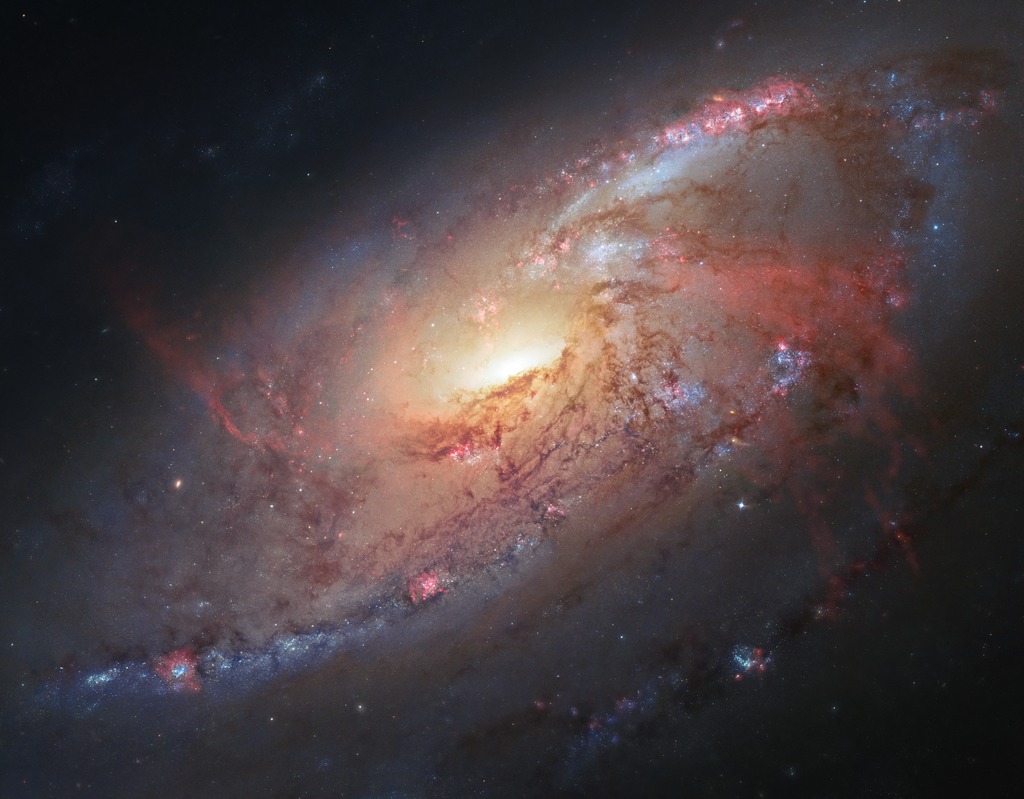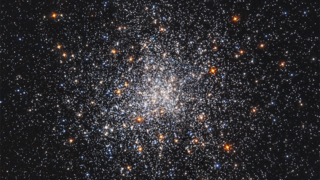Universe
ID: 30864

Working with astronomical image processors at the Space Telescope Science Institute in Baltimore, MD, astrophotographer Robert Gendler has taken science data from the Hubble Space Telescope (HST) archive and combined it with his own ground-based observations to assemble a photo illustration of the magnificent spiral galaxy M106.
Gendler retrieved archival Hubble images of M106 to assemble a mosaic of the center of the galaxy. He then used his own and fellow astrophotographer Jay GaBany's observations of M106 to combine with the Hubble data in areas where there was less coverage, and finally, to fill in the holes and gaps where no Hubble data existed.
The center of the galaxy is composed almost entirely of HST data. The outer spiral arms are predominantly HST data colorized with ground-based data taken by Gendler and GaBany. The image also reveals the optical component of the "anomalous arms" of M106, seen here as red, glowing hydrogen emission.
This portrait of M106 contains only the inner structure around the halo and nucleus of this active galaxy. Large amounts of gas from the galaxy are thought to be falling into and fueling a supermassive black hole contained in the nucleus. Also known as NGC 4258, M106 lies 23.5 million light-years away, in the constellation Canes Venatici.
Spiral Galaxy Messier 106 from Hubble

Gendler retrieved archival Hubble images of M106 to assemble a mosaic of the center of the galaxy. He then used his own and fellow astrophotographer Jay GaBany's observations of M106 to combine with the Hubble data in areas where there was less coverage, and finally, to fill in the holes and gaps where no Hubble data existed.
The center of the galaxy is composed almost entirely of HST data. The outer spiral arms are predominantly HST data colorized with ground-based data taken by Gendler and GaBany. The image also reveals the optical component of the "anomalous arms" of M106, seen here as red, glowing hydrogen emission.
This portrait of M106 contains only the inner structure around the halo and nucleus of this active galaxy. Large amounts of gas from the galaxy are thought to be falling into and fueling a supermassive black hole contained in the nucleus. Also known as NGC 4258, M106 lies 23.5 million light-years away, in the constellation Canes Venatici.
Related
For More Information
Credits
Please give credit for this item to:
Credit: NASA, ESA, the Hubble Heritage Team (STScI/AURA), and R. Gendler (for the Hubble Heritage Team)
Acknowledgment: J. GaBany
Credit: NASA, ESA, the Hubble Heritage Team (STScI/AURA), and R. Gendler (for the Hubble Heritage Team)
Acknowledgment: J. GaBany
Short URL to share this page:
https://svs.gsfc.nasa.gov/30864
Mission:
Hubble
Keywords:
SVS >> Galaxy
SVS >> Hyperwall
SVS >> Hubble Space Telescope
SVS >> Astronomy
NASA Science >> Universe
SVS >> Presentation
https://svs.gsfc.nasa.gov/30864
Mission:
Hubble
Keywords:
SVS >> Galaxy
SVS >> Hyperwall
SVS >> Hubble Space Telescope
SVS >> Astronomy
NASA Science >> Universe
SVS >> Presentation












